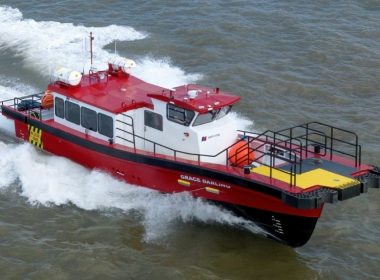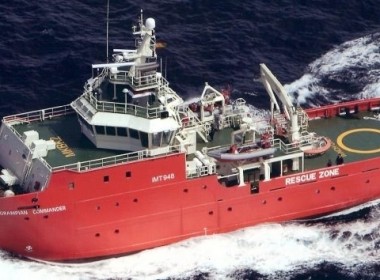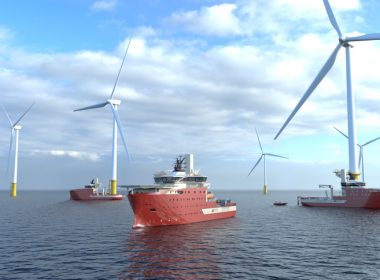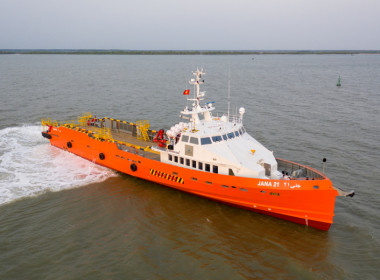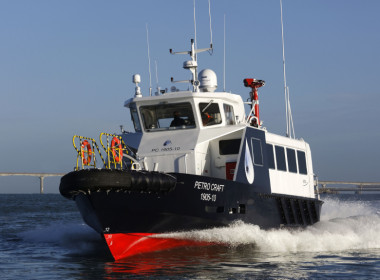AWARDS 2022 | Best OSV – Transfer Crewboat – Grace Darling – Chartwell Marine & North Star Group

Best OSV – Transfer Crewboat – Grace Darling – North Star Group & Chartwell Marine
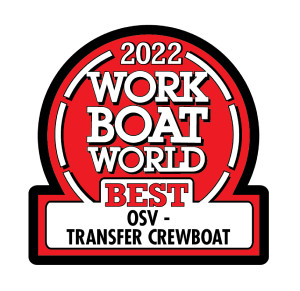
An exciting, and very different looking monohull, hybrid-powered, 12-metre boat is operating as a daughtercraft from larger vessels offshore the UK.
Apart from her radical looks, the boat is undoubtedly the first OSV to be equipped with twin diesel outboard motors. Her long-term performance will be closely studied.
“The vessel is the first in a series of new generation, purpose-built offshore wind daughtercraft (DC), combining the experience of offshore wind crewboat design with North Star’s experience of launch and recovery DC operations,” Andrew Duncan, renewables director for offshore wind at North Star, told Baird Maritime. “The concept was established to challenge the effective use of this class of vessels, increasing the often limiting conditions when a client can successfully use a DC for logistics offshore, whilst improving the comfort, efficiency, and emissions through innovations in technology and design.”
Duncan said that North Star adopted a hands-on approach in the design collaboration, the performance modelling, and the project management of the vessel. The company collaborated with the Carbon Trust’s Offshore Wind Accelerator programme for the design phase of the vessel build with the aim of reducing carbon emissions and improving performance. This was achieved through tank testing and analysing multiple bow fenders to enhance sea state operability and safe transfers, whilst ensuring that the vessel has fully electric propulsion to reduce emissions.
“The vessel has a seakeeper gyro onboard and an advanced fender system that maximises offshore turbine transfer performance,” added Chartwell Marine Managing Director Andy Page. “It was borne out of a Carbon Trust technology accelerator project and is a great example of how industry collaboration can deliver a great product.”
Page remarked that the hybrid system proved challenging in terms of both weight and size when it came to its integration on board the vessel.
“With a daughtercraft, not only do you need to consider waterborne performance but also launch and recovery operations with varying onboard payloads. It is lots to think about, especially when incorporating new technologies on board.”
“It was a complex project with the inherent logistical challenges of an international endeavour of such scale,” added Duncan. “Thankfully, we have a proven, robust, and risk-adverse newbuild programme strategy in place to ensure a reliable on time and on budget service no matter what the market conditions are.”
Duncan said the integration of a hybrid power management and electrical propulsion package in the DC required tuning. The use of diesel outboard engines, which were selected for their redundancy options, and noise and vibration qualities enable the further adjustment of the ratios of electric to combustion propulsion as the technologies evolve in the following years. Trials have demonstrated the effectiveness of these units to allow silent, emission-free sailing with up to one tonne of cargo at 10 knots.
“The quest for improved offshore workability with respect to in-field access in sea states in excess of 1.5-metre significant wave heights has now become the norm since North Star revealed the effectiveness of this particular DC,” Duncan replied when asked to comment on trends impacting the offshore industry. “This is nearly a 50 per cent improvement. Since we unveiled our DC design, its capabilities regarding multiple deployments and safety are now leading conversations in the offshore wind logistics support space.”
Duncan said that the previous year was a “busy and pivotal one” for North Star. The company was able to secure SOV contracts, contributing to its strategic growth plans within the UK offshore wind market.
“Extending our organisational excellence in offshore infrastructure support into renewables has demonstrated our ability to scale up our operations seamlessly, showcasing our ability to project manage multiple simultaneous newbuilds and the expertise of our crew and onshore personnel. These vessels are already making their way to UK waters, with all four SOVs scheduled to arrive in the next two years.”
North Star also successfully fortified its ability to build additional new vessels for the offshore wind market through a successful debt raising process of £127 million (US$158.1 million). Duncan said that, with the equity backing of new owners global private markets firm Partners Group, North Star in a robust financial position to realise its offshore wind ambitions in Europe and elsewhere while maintaining its market position in the emergency response and rescue vessel (ERRV) market.
“For us, 2022 was a fantastic year,” Page told Baird Maritime. “We were fortunate to win a number of awards in recognition of our successes both as a business and technology developer in both at home and abroad.”
With regards to the future of the offshore industry, Page believes research and development into alternative fuels and energy provision is gaining in terms of technology readiness level and is being incorporated into vessels in the UK and worldwide.
“Critically our key work must be in training and skill development, not just in new technology but also in shipbuilding as a whole. We need to make sure that skills are passed on so we can keep developing new boats and re-energising old ones.”
“As the maritime sector implements strategies to move away from its dependency on fossil fuels,” added Duncan, “our new offshore wind fleet has been specifically designed with sustainability and future fuels in mind. As our clients seek ways of integrating within the windfarm infrastructure to support SOVs’ fuel or power requirements, we are collaborating with other technology partners to develop methods of in-field fuelling or charging.
Duncan said North Star’s newbuild design is tailored for shore-based power connectivity, so the next step is to have an offshore connection. The company has therefore formed close relationships with in-field battery charging technology providers to assist in making that goal a possibility.
“In-field charging is the long-term solution to decarbonising SOVs, but we have also taken steps in the short term through alternative fuels and efficient propulsion technologies.”
Duncan believes collaboration with UK companies and technology partners and hiring local talent whenever possible are keys to North Star’s success in the British workboat industry.
“We fully support the UK shipbuilding industry and we are very fortunate to have a wealth of talent readily available to us in the North East,” he told Baird Maritime. “We are committed to investing in the local supply chain when we can to help drive forward our ongoing investment in the UK economy and support our continued growth in the UK and European offshore wind markets.”
For a list of the 2022 “Best Of” award winners, please click here.





